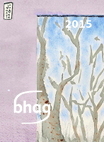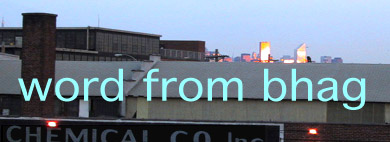b h a g . n e t visual and conceptual exchange b h a g . n e t


bhag cover page Return to current word from bhag
September 14, 2003
ANOTHER PATH
by John Clay, editor-in-chief
Anyone who has sought to publish their works in a magazine probably knows the unhappy experience of being rejected, with or without comment. But they probably also know the equally unfulfilling experience of being accepted by a magazine that accepts everything, without comment. These experiences reflect two standard approaches to publishing: closed access and open access. I'll call them the art-in-itself magazine and the parking lot magazine. A magazine can be a work of art in itself. The editor selects and rejects works like hues of paint from a palette—choosing this one but not that. Or a magazine can be like a parking lot. Anyone can park their vehicle of expression in the lot—for free or for a fee—and walk away.
Both approaches have their merits and limitations. It all turns upon the questions of access and expression. The question, Who will be granted access? is a function of the question, Whose expression?
The closed access "art-in-itself" magazine is ultimately a vehicle for expressing the editor's own view of life and art. It upholds the editor's right to freedom of self-expression and yields its own unique contribution to culture, not unlike a book of collected poems, brought together by an admiring editor rather than by the poet. Editorial selection is a form of commentary on others' works—that is, commentary on some of the works precolating throughout the culture.
The open access "parking lot" magazine is a vehicle for expressing, within the limits wrought by language or logistics, everyone's worldviews. It upholds the democratic ideal of universal participation and in one sense represents a microcosm of human culture: the whole manifests the parts, culture is made by everyone.
The limitation of the closed access approach rests precisely in...the limitations. The art-in-itself magazine closes the door on artworks which, while disagreeable to the editor, might be valuable contributions to culture.
The open access approach suffers chiefly from its newness. The closed access magazine is by far the dominant version in publishing, and the open access alternative is still hard for most people to grasp. Most magazine editors insist on keeping a tight hold on the reins. And if access is going to be open, then they throw up their hands and say, If I'm not selecting and rejecting works, then what am I here for? As a result, open access magazines typically replace the editor with a ticket-taker who tallies your entry and maybe exacts a fee as well. The magazine turns into a parking lot. The absence of the editorial role—someone making choices and offering comments—can't help but evoke a sense of abandonment, leaving the artist feeling invisible even when published. Bhag has found another path.
Bhag provides open access but in a sense that erases the analogy to parking lots. Bhag is something like a town meeting, in that anyone can speak as long as they are not hatemongering or threatening violence against anyone else. But they can't expect to just walk away without any reaction either. Stand up in a meeting and speak, and someone will let you know what they think. Everyone who publishes in bhag will receive our editorial feedback. (Whether you will ever hear any word from bhag's readers, we cannot know or guarantee. But you should always hear from bhag's editors. And if you don't—please let us know.)
Our mission is to provide editorial feedback that is constructive even when critical. We seek to be as specific, constructive, and courteous as possible in explaining, within the scope and limits of our own expertise, what we like and why, or what we feel does not work and why. Upon receiving our feedback about your work, you can make revisions, or tell us to publish it as-is, or withdraw your submission. The choice is yours. I don't know of any magazine—online or print—that offers this combination of open access and constructive editorial feedback.
The effects of feedback are beneficial to all involved: artists, editors, readers. When people talk together, they mutually test their ideas and skills with each other and refine them in the process. It is not only the artists who gain an opportunity to refine their work. The editors too, on receiving the artist's response (I agree, I disagree, Please publish as is, Please publish with the following revisions) gain the opportunity to refine skills and test whether we are being reasonable. Bhag's path is open, socially responsive, and socially responsible. It is our hope that the result for readers is a better total magazine.
© 2003 John Clay
Return to current word from bhag